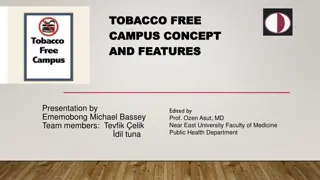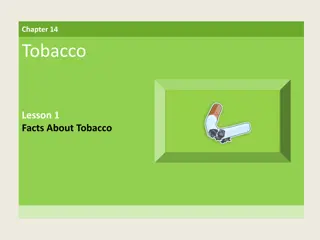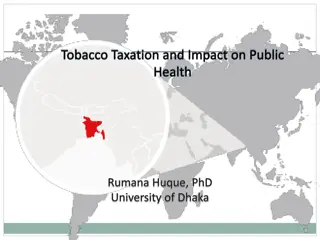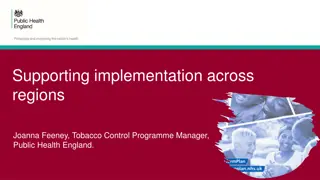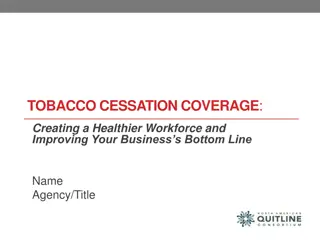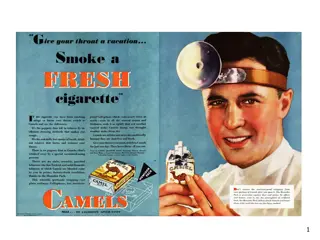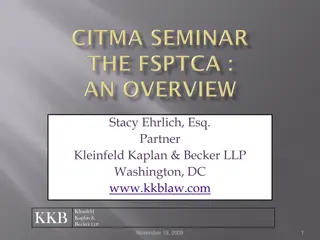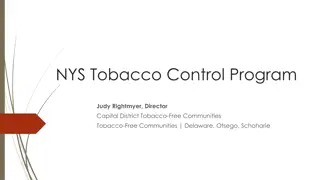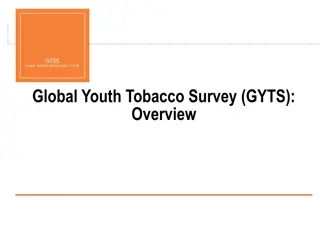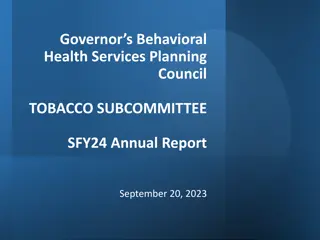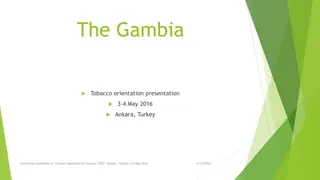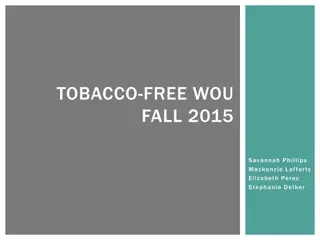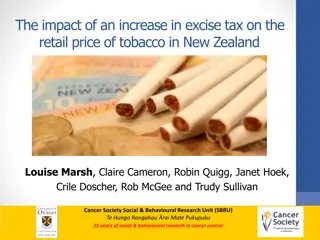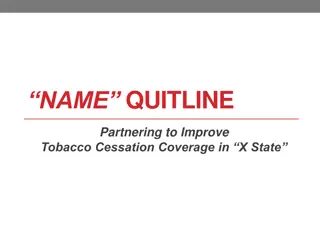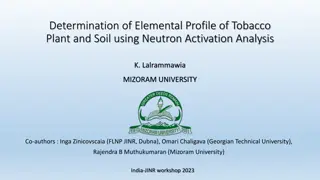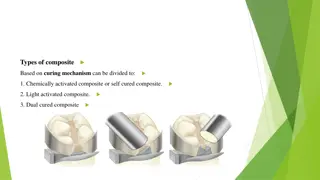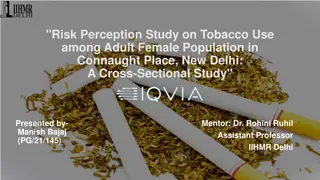Ensuring Flue-Cured Tobacco Barn Safety: Testing Procedures and TSNA Formation
Flue-cured tobacco barns require regular CO2 emissions testing every 3 years to maintain heating system integrity. This process involves specific steps such as preliminary reporting, setting barn conditions, and conducting the test. Additionally, understanding TSNA formation in tobacco sheds light on the mechanisms causing the compound's occurrence. Farmers should adhere to established protocols and keep accurate testing records to comply with US Tobacco GAP standards.
Download Presentation

Please find below an Image/Link to download the presentation.
The content on the website is provided AS IS for your information and personal use only. It may not be sold, licensed, or shared on other websites without obtaining consent from the author.If you encounter any issues during the download, it is possible that the publisher has removed the file from their server.
You are allowed to download the files provided on this website for personal or commercial use, subject to the condition that they are used lawfully. All files are the property of their respective owners.
The content on the website is provided AS IS for your information and personal use only. It may not be sold, licensed, or shared on other websites without obtaining consent from the author.
E N D
Presentation Transcript
U.S. Tobacco GAP Barn Testing Procedure We Bring Engineering to Life
Barn Testing Overview Flue-cured barn heating system integrity assessment Heating systems must be tested every 3 years for CO2 emissions The cost and scheduling of testing is the responsibility of the grower Testing can be conducted by independent third-party companies or individual growers, but all entities testing barns for the US Tobacco GAP Program must attend a Cooperative Extension training Common testing procedure and reporting form Barn testing records are to be kept by the contract grower
TSNA Formation TSNA formation in flue-cured tobacco (1) Naturally occurring microbial process (2) Exposure to Nitrogen Oxide compounds from the combustion process react with alkaloids in the green leaf during the curing process Mechanism (2) >> (1)
Why measure CO2? Typical stack gas CO2 levels >> 1 ppm 10% to 13.5% (Actual) Equipment cost and complexity Commercially available meters Simple and direct process Portable instrumentation Typical Ambient CO2 Levels 300 500 ppm
Step 1: Barn Testing Report Preliminary Information Farmer or Farm name and address Location of barns Testing date Total number of barns to be tested Testing entity company name or individual name CO2 probe serial number and calibration information Barn ID numbers If barns are tested at multiple locations for an individual farm then separate reports should be completed to record the location of the barns.
Step 2: Barn Settings Prior to conducting the initial measurements, make sure: Barn is at ambient (outside) temperature and empty. Fan is ON Heat is OFF Fresh air dampers are CLOSED.
Step 3: Conducting the Barn Test Leave the fan ON Record the initial (ambient) CO2 level inside the barn Advance the thermostat 20o to 30oF above the ambient air temperature to ensure the burner will run continuously for 10 minutes. Depending on the ambient temperature, the thermostat set point above ambient that will result in the burner operating continuously for 10 minutes may be less than 20oF. Continue to monitor the levels for approximately 10 minutes after the burner ignites and record the final (10 minute) CO2 measurement.
Step 4: Heat Exchanger Status Calculate the difference between the barn initial (ambient) CO2 level and the final (10 minute) CO2 measurement. If the difference measured is LESS than 200 ppm, the heat exchanger status is PASS. If the difference measured is GREATER than 200 ppm, the heat exchanger status is FAIL and must be retested after repairs are made. Barns with a FAIL status must both be repaired and retested or removed from service. Results of the barn testing along with a copy of the CO2 probe calibration are to be left with the grower.
Barn Testing Notes: Allow the CO2 meter to warm up for approximately 5 minutes initially. Observe the maximum operating environment temperature specified by the CO2 meter manufacturer. This typically ranges from 120oF to 140oF. The meter probe may be placed inside the barn through the front exhaust vent or, if available, access doors at the rear of the barn. Typical ambient CO2 levels range from 300 ppm to 500 ppm. Ambient readings outside this range may indicate a faulty CO2 probe or instrument error. If the CO2 level increase exceeds 200 ppm prior to the burner operating for 10 minutes continuously, the procedure may be stopped and the barn status listed as FAIL.
Commercial CO2 Meters and Recommended Specifications Extech EA80 (www.extech.com/instruments/) Vaisala GM70 or Indigo 201 (www.vaisala.com) Recommended Minimum Specifications Resolution: Accuracy: Measurement Range: 0 2,000 ppm (0-5,000 ppm) CO2 sensor calibration certificate 1 ppm CO2 +/- 50 ppm CO2
Carbon Dioxide Meters *Vaisala GMT222 (No longer available) Vaisala GM70 Vaisala Indigo 201 Extech EA80 Testo 535
Common Sources of Leaks Inspect all exhaust flue-pipe joints (elbows, etc.), if applicable, that are located inside the barn. Especially flue-pipe joints that are simply connected with sheet metal screws and/or some type of compression or clamp style fittings. Some of these connections are located directly in the return air stream, which typically is the low-pressure side of the fan. Also the floor style heat exchanger systems that use multiple pipes spanning the length of the barn should be checked for connection leaks. A high temperature sealant may be needed in addition to any mechanical fasteners to properly seal the connection from leaking exhaust gases. The best solution would be to minimize or eliminate the flue-pipe connections located inside the barn.
Leaks continued Closely inspect the heat exchanger surfaces for cracks. The firebox or combustion chamber, which typically will be the hottest part on the heat exchanger, may be the first location on the heat exchanger to develop cracks. Also closely inspect all weld joints. Flame impingement or direct contact with firebox surfaces can accelerate cracking.
Leaks continued Although the CO2 test is not used to determine if the stack exhaust gases are being pulled back into the barn when the fan fresh air intake vents are open, growers should be aware of the stack height relative to the top of the barn. It is possible that exhaust gases could be pulled back into the barn when the vents are open even if the heat exchanger and other sources mentioned are not leaking. This is especially the case during leaf drying when ventilation is typically at a maximum. The stack height should meet the minimum recommended height of 24 inches above the highest point of the barn roof.
CO2 Barn Testing Meter Update Vaisala GMT 222 unit has been replaced with Indigo 201 unit $474 $123 (10 m cable for probe) Vaisala GMP 252 CO2 probe for ppm measurements (0-2000 ppm) $649 $280 (probe recalibration) Annually (every two years maximum interval) Total = $1,246 (meter, probe, cable) GM70 portable CO2 meter $2,039 Vaisala will continue to support GMT 222 products for a few more years Vaisala contact; Yani Bettencourt Vaisala Inc., Controlled Environment 10D Gill St. Woburn, MA 018101 781-537-1058 yani.bettencourt@vaisala.com
Vaisala GMP 252 CO2 Probe and Indigo-201Transmitter 10 m (32.8 ft) cable http://www.vaisala.com/en/products/carbondioxide/Pa ges/GMP252.aspx http://www.vaisala.com/en/industrialmeasurements/ products/accessories/Pages/Indigo-201.aspx GMT 222
Vaisala Calibration and Repairs Services https://store.vaisala.com/en




